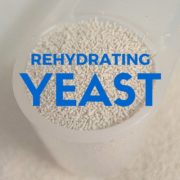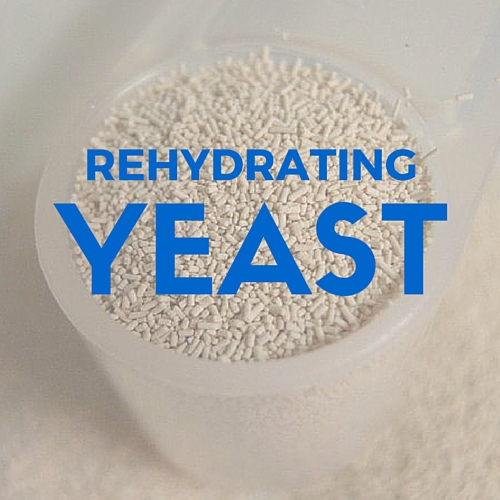Rehydrating Dry Yeast FTW!
I have seen various debates regarding the usage of dry yeast. Tthe main point of contention being whether the home brewer should rehydrate the yeast, or whether the yeast should just be sprinkled on top of the cooled wort.
It clearly seems to be a hot topic of debate but I think there is only one thing you should be doing and that’s making sure you are pitching viable yeast in at a high enough cell count. Rehydrating yeast will usually provide a higher number of viable cells in relation to the amount of yeast pitched, we will find out why further down the post
In this post I am going to tell you how to rehydrate yeast and offer some reasons why you should bother.
Why You Should Consider Rehydrating Yeast
I think the reason why there is so many differing opinions regarding whether you rehydrate or just sprinkle the yeast on the wort is because the beer almost always ferments either way. Yes, that’s right the wort will usually ferment all the way out whether you bother to rehydrate the dry yeast or not, so why would you bother?
The best argument I have found is here, This is an exchange with a home brew retailer and Dr. Clayton Cone of Lallemand who produce the Danstar yeast range.
Dr. Clayton Cone suggests the following:
Let me give you some facts regarding rehydration and you can decide for yourself where you want to compromise.
Every strain of yeast has its own optimum rehydration temperature. All of them range between 95 F to 105F. Most of them closer to 105F. The dried yeast cell wall is fragile and it is the first few minutes (possibly seconds) of rehydration that the warm temperature is critical while it is reconstituting its cell wall structure.
As you drop the initial temperature of the water from 95 to 85 or 75 or 65F the yeast leached out more and more of its insides damaging the each cell. The yeast viability also drops proportionally. At 95 – 105 F, there is 100% recovery of the viable dry yeast. At 60F, there can be as much as 60% dead cells. The water should be tap water with the normal amount of hardness present. The hardness is essential for good recovery. 250 -500 ppm hardness is ideal. This means that deionized or distilled water should not be used. Ideally, the warm rehydration water should contain about 0.5 – 1.0% yeast extract.
For the initial few minutes (perhaps seconds) of rehydration, the yeast cell wall cannot differentiate what passes through the wall. Toxic materials like sprays, hops, SO2 and sugars in high levels, that the yeast normally can selectively keep from passing through its cell wall rush right in and seriously damage the cells. The moment that the cell wall is properly reconstituted, the yeast can then regulate what goes in and out of the cell. That is why we hesitate to recommend rehydration in wort or must. Very dilute wort seems to be OK.
How do many beer and wine makers have successful fermentations when they ignore all the above? I believe that it is just a numbers game. Each gram of Active Dry Yeast contains about 20 billion live yeast cells. If you slightly damage the cells, they have a remarkable ability to recover in the rich wort. If you kill 60% of the cell you still have 8 billion cells per gram that can go on to do the job at a slower rate.
What you glean from this is up to you. I would say that knowing that 60% of the dry yeast you sprinkle on top of the wort will die is something you should definitely consider.
The high cell count in a sachet of yeast is the principle reason for successful fermentations even though over half of that yeast could die straight away. If you brew small batches this is fine but for 5+ gallon batches I would rehydrate every time.
Rehydrating Dry Yeast
So to ensure a high cell count of healthy yeast we want to rehydrate properly, first of all make sure everything you use is meticulously sanitised, this goes without saying. Here is how I do it:
1. Put around 250 ml of boiled tap water into a sanitised measuring jug and cool to 35°C (95°F)
2. Sprinkle your dry yeast onto the surface of the warm water, don’t worry about stirring or aerating or adding sugar. Cover with some aluminum foil and leave it for about 15 minutes.
3. Swirl the jar to suspend the yeast, you can stir as well but swirling works just as well and doesn’t involve sanitising a spoon.
4. Leave for another 10 minutes. It’s now ready to be pitched into your cooled, aerated wort. To do this swirl the jug to get all the yeast back into suspension and pour the whole lot in.
If you are rehydrating your yeast then use it within 30 minutes of rehydrating for the best results.
I used to always sprinkle yeast on the surface of the wort and not bother rehydrating, in all honesty though the time it takes to rehydrate yeast and the higher viability it provide means I now make an effort to rehydrate if I have the time. If I am making a small batch like 3 gallons I generally don’t but for a normal brew length of 5 gallons I almost always will.
Most brewers tend to be meticulous with everything else on brew day so why not take the extra 15 minutes to rehydrate your yeast. What harm can it do given the evidence. It should be noted however that the best practice is to follow the recommendations on the packet as these will always provide the best results.
Of course I’m not saying you have to rehydrate yeast and as long as the packet is within it’s use by date there is usually high enough cell count in a sachet of yeast for 5 gallons if pitched directly into the cooled beer. Rehydrating the yeast will however increase the amount of cells that are viable when you pitch that very same sachet.






Leave a Reply
Want to join the discussion?Feel free to contribute!